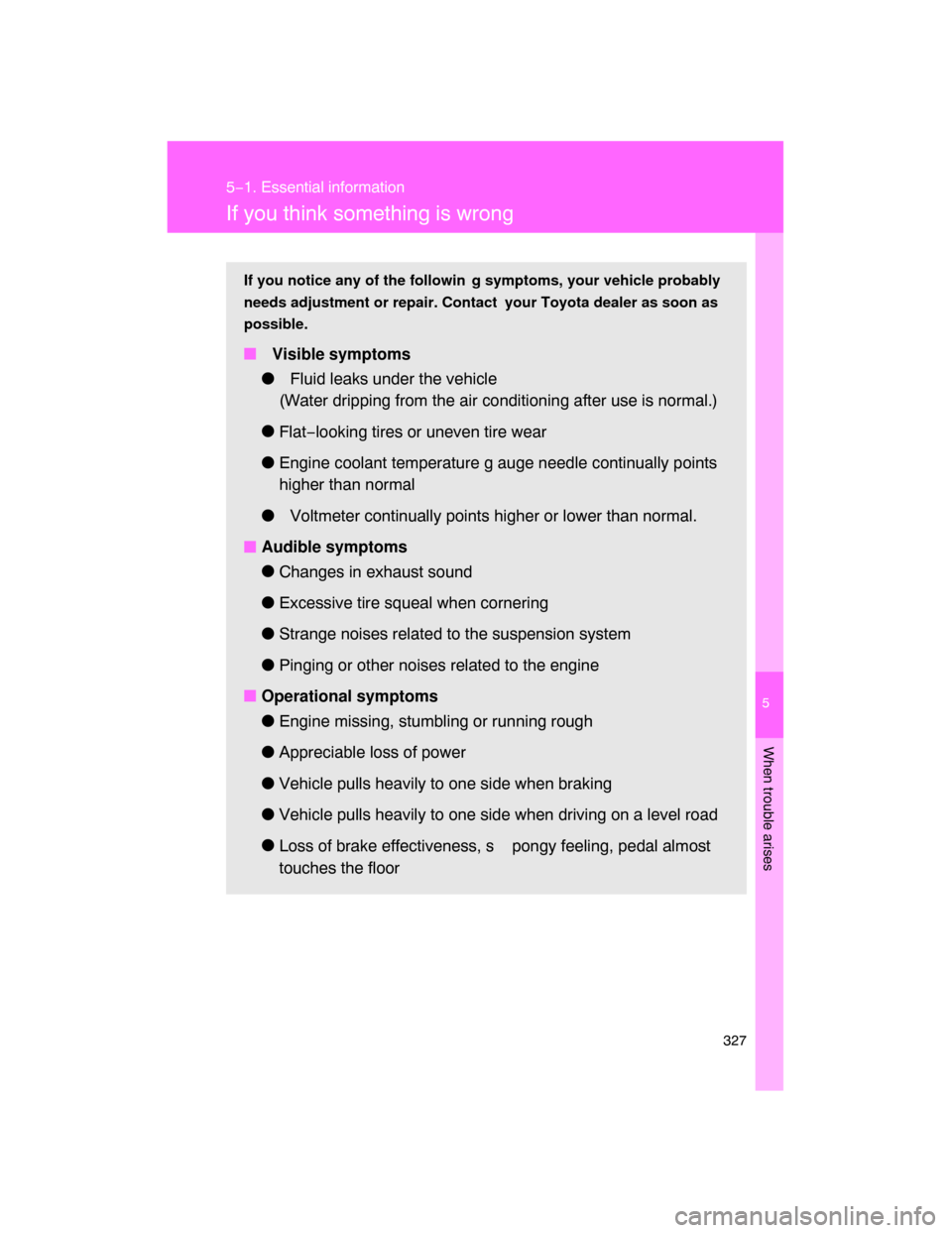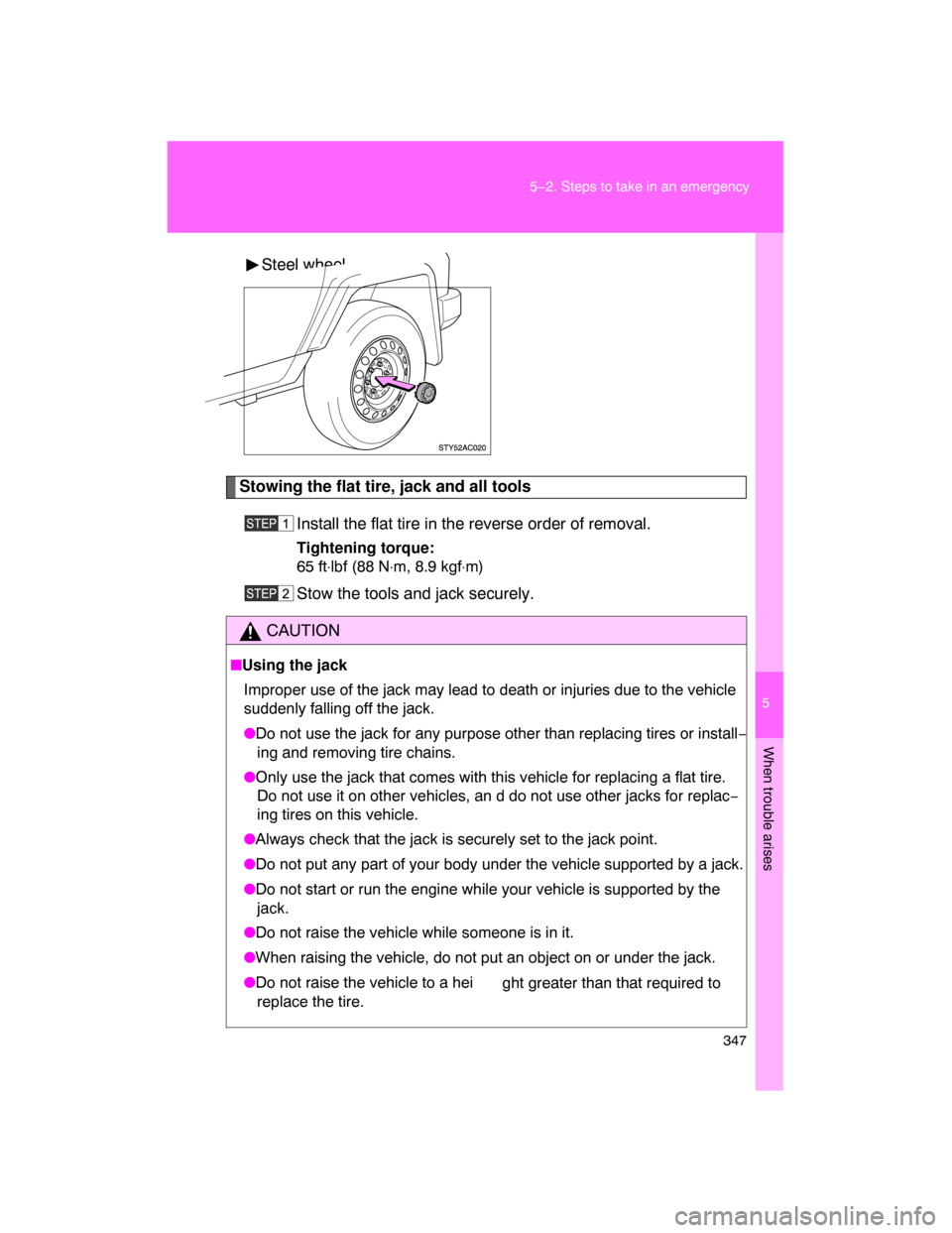Page 293 of 400
297
4−3. Do−it−yourself maintenance
4
Maintenance and care
CAUTION
�When replacing wheels
�Do not use wheels that are a different size from those recommended in
the Owner ’s Manual, as this may result in loss of handling control.
�Never use an inner tube in a leaking wheel which is designed for a
tubeless tire. Doing so may result in an accident, causing death or seri−
ous injury.
NOTICE
�Replacing tire pressure warning valves and transmitters
�Because tire repair or replacement may affect the tire pressure warn−
ing valves and transmitters, make su re to have tires serviced by your
Toyota dealer or other qualified service shop. In addition, make sure to
purchase your tire pressure warning valves and transmitters at your
Toyota dealer.
�Ensure that only Genuine Toyota wheels are used on your vehicle.
Tire pressure warning valves and transmitters may not work properly
with non−genuine wheels.
Page 322 of 400

5
When trouble arises
327
5−1. Essential information
If you think something is wrong
If you notice any of the followin g symptoms, your vehicle probably
needs adjustment or repair. Contact your Toyota dealer as soon as
possible.
� Visible symptoms
� Fluid leaks under the vehicle
(Water dripping from the air conditioning after use is normal.)
�
Flat−looking tires or uneven tire wear
�Engine coolant temperature g auge needle continually points
higher than normal
� Voltmeter continually points higher or lower than normal.
�Audible symptoms
�
Changes in exhaust sound
�
Excessive tire squeal when cornering
�Strange noises related to the suspension system
�
Pinging or other noises related to the engine
�
Operational symptoms
�Engine missing, stumbling or running rough
�
Appreciable loss of power
�
Vehicle pulls heavily to one side when braking
�Vehicle pulls heavily to one side when driving on a level road
�
Loss of brake effectiveness, s pongy feeling, pedal almost
touches the floor
Page 332 of 400

5
When trouble arises
337 5−2. Steps to take in an emergency
�If the tire pressure warning system is inoperative
The tire pressure warning system may become inoperative in the follow−
ing conditions:
(When the condition be
comes normal, the system will work properly.)
�If tires not equipped with tire pressure warning valves and transmit−
ters are used.
�If the ID code on the tire pressure warning valves and transmitters is
not registered in the tire pressure warning computer.
�If electronic devices or facilities us ing similar radio wave frequencies
are nearby.
�If a radio set at similar frequencies is in use in the vehicle.
�If a window tint that affects the radio wave signals is installed.
�If there is a lot of snow or ice on the vehicle, in particular around the
wheels or wheel housings.
�If non−genuine Toyota wheels are used.
�If tire chains are used.
�If the spare tire is in a location subject to poor radio wave signal
reception.
�If the tire inflation pressure is more than 73 psi (500 kPa, 5.1 kgf/cm2
or bar) or higher.
�If the tire pressure warning light comes on after blinking for 1
minute frequently
If the tire pressure warning light comes on after blinking for 1 minute fre−
quently when the engine switch is
turned to the ON position, have it
checked by your Toyota dealer.
� After changing the engine oil (U.S.A. only)
Make sure to reset the oil maintenance data. ( P. 278)
� Customization that can be configured at Toyota dealer
The vehicle speed linked seat belt reminder buzzer can be disabled.
(Customizable features
P. 386)
Page 333 of 400

338 5−2. Steps to take in an emergency
CAUTION
�Maintenance of the tire
Each tire, including the spare (if provided), should be checked monthly
when cold and inflated to the inflation pressure recommended by the
vehicle manufacturer on the vehicle
placard or tire inflation pressure
label (tire and load information label). (If your vehicle has tires of a differ−
ent size than the size indicated on the vehicle placard or tire inflation
pressure label [tire and load information label], you should determine the
proper tire inflation pr
essure for those tires.)
As an added safety feature, your
vehicle has been equipped with a tire
pressure monitoring system (TPMS−ti re pressure warning system) that
illuminates a low tire pressure telltal e (tire pressure warning light) when
one or more of your tires is significantly under−inflated. Accordingly,
when the low tire pressu
re telltale (tire pressure warning light) illumi−
nates, you should stop and check your tires as soon as possible, and
inflate them to the proper pressure. Driving on a significantly under−
inflated tire causes the tire to overheat and can lead to tire failure.
Under−inflation also reduces fuel effi
ciency and tire tread life, and may
affect the vehicle’s handling and stopping ability.
Please note that the TPMS (tire pressure warning system) is not a sub−
stitute for proper tire main tenance, and it is the driver ’s responsibility to
maintain correct tire pressure, even if under−inflation has not reached the
level to trigger illu
mination of the TPMS low ti re pressure telltale (tire
pressure warning light).
Your vehicle has also been equipped with a TPMS (tire pressure warning
system) malfunction indicator to indi cate when the system is not operat−
ing properly. The TPMS (tire pressure warning system) malfunction indi−
cator is combined with the low tire pressure telltale (tire pressure
warning light). When the system det
ects a malfunction, the telltale will
flash for approximately one minute an d then remain continuously illumi−
nated. This sequence will
continue upon subsequent vehicle start−ups as
long as the malfunction exists. When the malfunction indi cator is illumi−
nated, the system may not be able to detect or signal low tire pressure
as intended.
Page 334 of 400

5
When trouble arises
339 5−2. Steps to take in an emergency
CAUTION
TPMS (tire pressure warning system ) malfunction may occur for a vari−
ety of reasons, including the installati
on of replacement or alternate tires
or wheels on the vehicle that prevent the TPMS (tire pressure warning
system) from functioning properly. Always check the TPMS (tire pres−
sure warning system) malfunction te
lltale after replacing one or more
tires or wheels on your vehicle to ensure that the replacement or alter−
nate tires and wheels allow the TPMS (tire pressure warning system) to
continue to function properly.
�If the tire pressure warning light comes on
Be sure to observe the following precautions. Failure to do so could
cause loss of vehicle control and result in death or serious injury.
�Stop your vehicle in a safe place as
soon as possible. Adjust the tire
inflation pressure immediately.
�If the tire pressure warning light comes on even after tire inflation pres−
sure adjustment, it is probable that you have a flat tire. Check the tires.
If the tire is flat, change to the spare tire and have the flat tire repaired
by the nearest Toyota dealer.
�Avoid abrupt maneuvering and braking. If the vehicle tires deteriorate,
you could lose control of the steering wheel or the brakes.
�If a blowout or sudden air leakage should occur
The tire pressure warning system may not activate immediately.
NOTICE
�Precaution when installing a different tire
When a tire of a different specification or maker is installed, the tire pres−
sure warning system may
not operate properly.
Page 337 of 400
342 5−2. Steps to take in an emergency
Turn the hold−down nuts counter−
clockwise with the wheel nut
wrench and remove them.
Replacing a flat tire
Chock the tires.
Flat tireWheel
chock
positions
Front
Left−
hand
sideBehind the
rear right−
hand side
tire
Right−
hand
sideBehind the
rear left−
hand side
tire
Rear
Left−
hand
sideIn front of
the front
right−hand
side tire
Right−
hand
sideIn front of
the front
left−hand
side tire
Page 342 of 400

5
When trouble arises
347 5−2. Steps to take in an emergency
Steel wheel
Stowing the flat tire, jack and all tools
Install the flat tire in the reverse order of removal.
Tightening torque:
65 ft⋅lbf (88 N⋅m, 8.9 kgf⋅m)
Stow the tools and jack securely.
CAUTION
�Using the jack
Improper use of the jack may lead to death or injuries due to the vehicle
suddenly falling off the jack.
�Do not use the jack for any purpose other than replacing tires or install−
ing and removing tire chains.
�Only use the jack that comes with this vehicle for replacing a flat tire.
Do not use it on other vehicles, an d do not use other jacks for replac−
ing tires on this vehicle.
�Always check that the jack is securely set to the jack point.
�Do not put any part of your body under the vehicle supported by a jack.
�Do not start or run the engine while your vehicle is supported by the
jack.
�Do not raise the vehicle while someone is in it.
�When raising the vehicle, do not put an object on or under the jack.
�Do not raise the vehicle to a hei
ght greater than that required to
replace the tire.
Page 344 of 400
5
When trouble arises
349 5−2. Steps to take in an emergency
NOTICE
�Do not drive the vehicle with a flat tire.
Do not continue driving with a flat tire.
Driving even a short distance with a flat tire can damage the tire and the
wheel beyond repair.
�When replacing the tires
�When removing or fitting the wheels, tires or the tire pressure warning
valve and transmitter, contact your Toyota dealer as the tire pressure
warning valve and transmitter may be damaged if not handled cor−
rectly.
�Replace the grommets for the tire pressure warning valves and trans−
mitters as well.
�To avoid damaging the tire pressure warning valves and transmit�
ters
Do not use liquid sealants on flat tires.
�To prevent damage to the wheel ornament (vehicles with a steel
wheel)
Do not attach wheel ornament to the wheel on the back door.